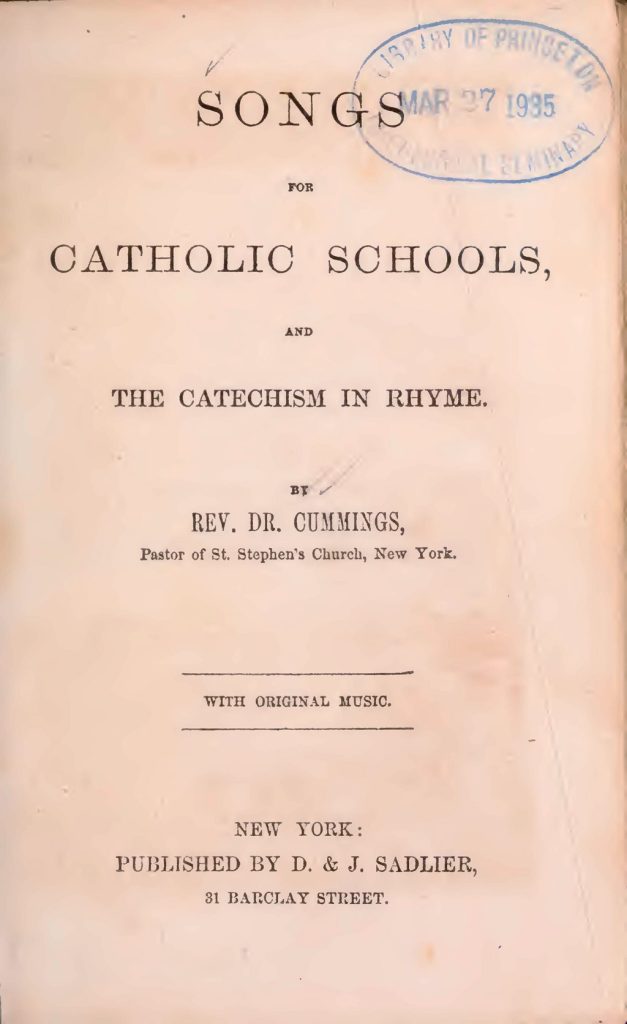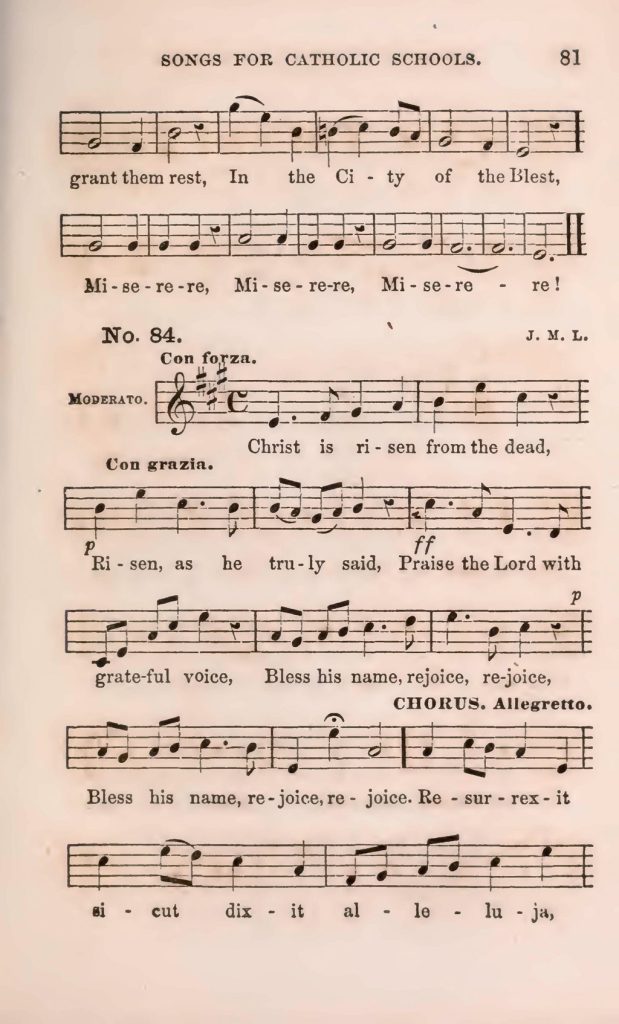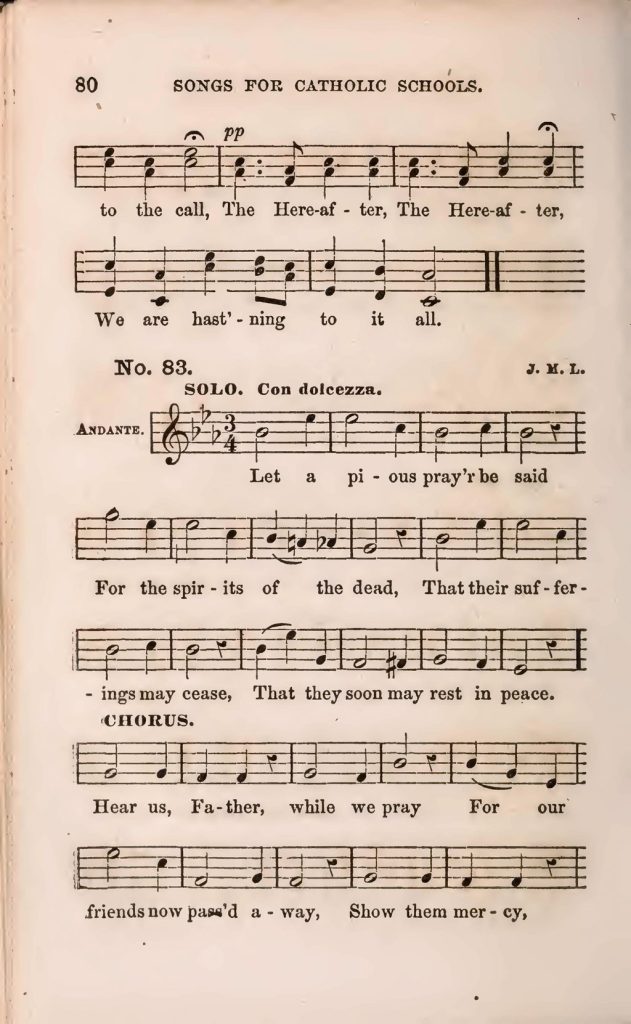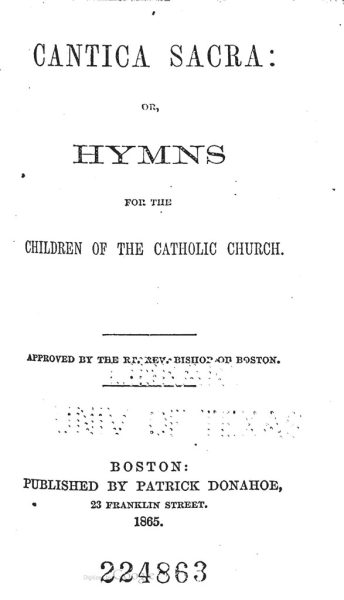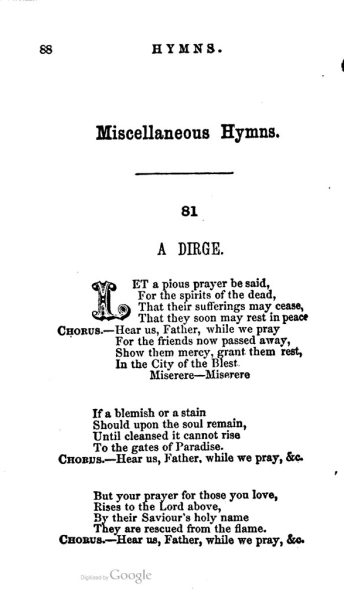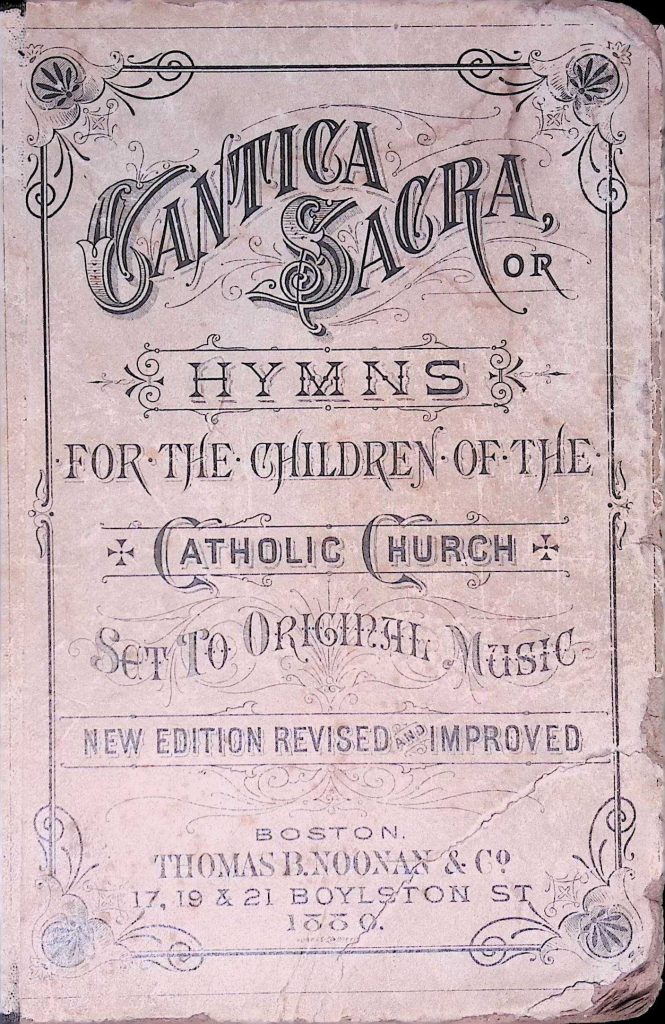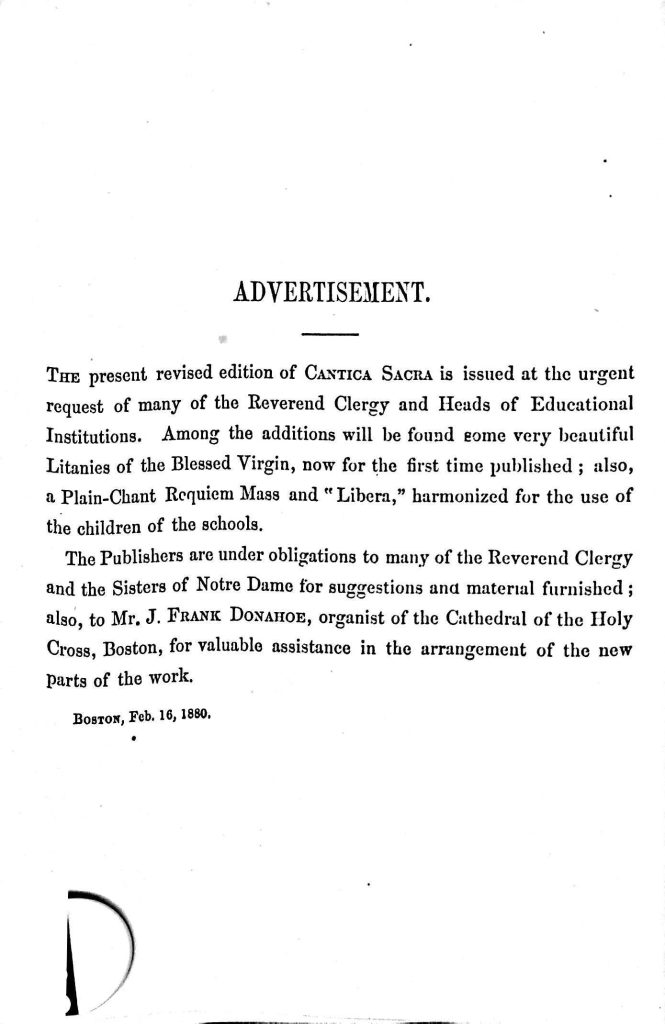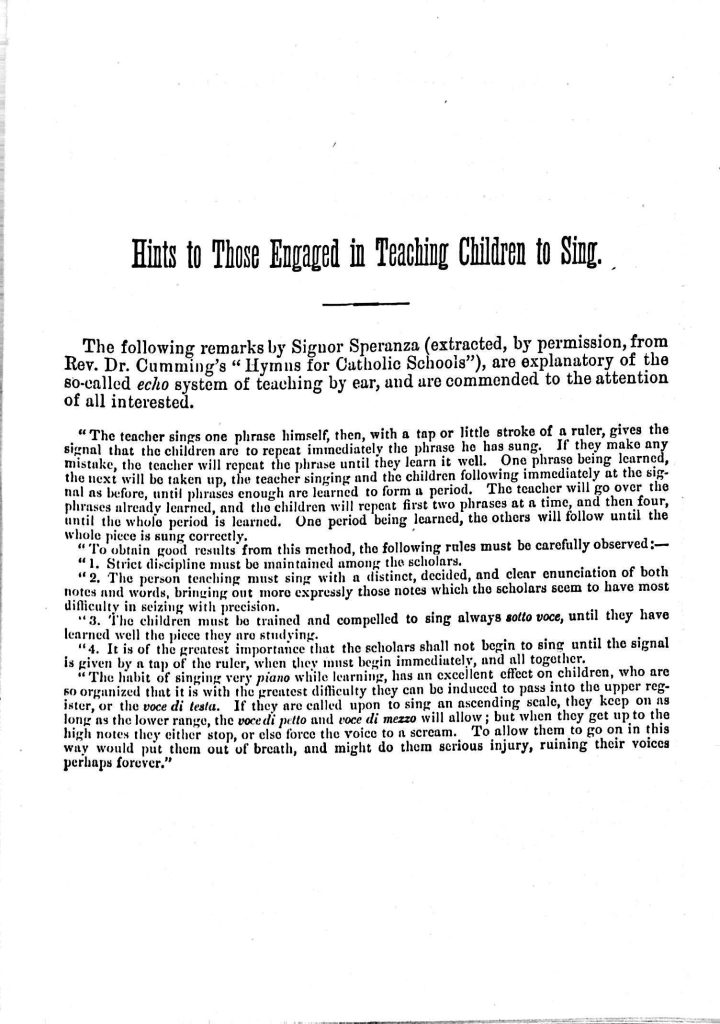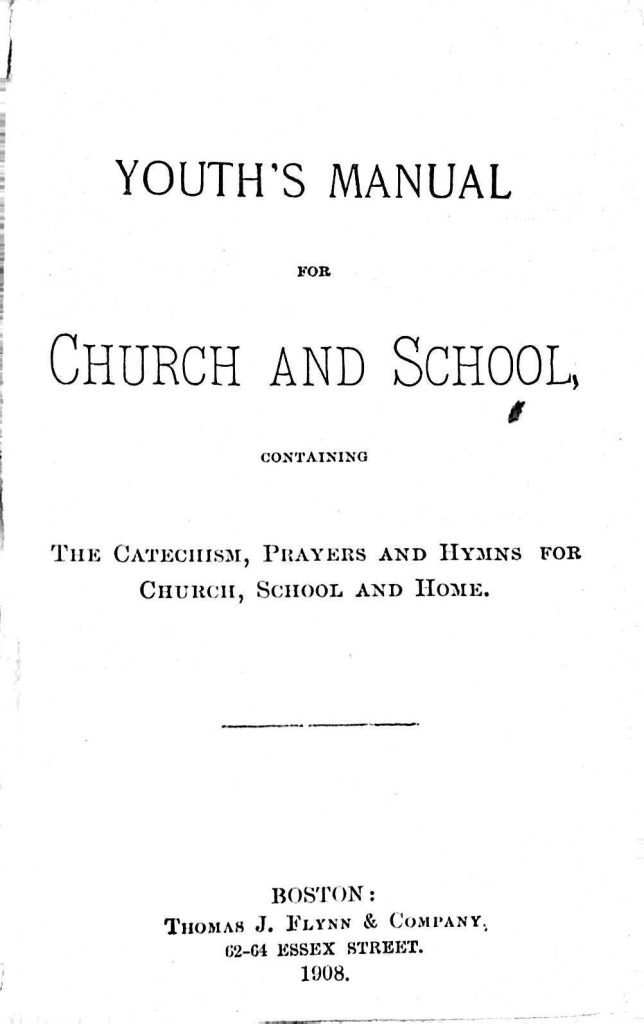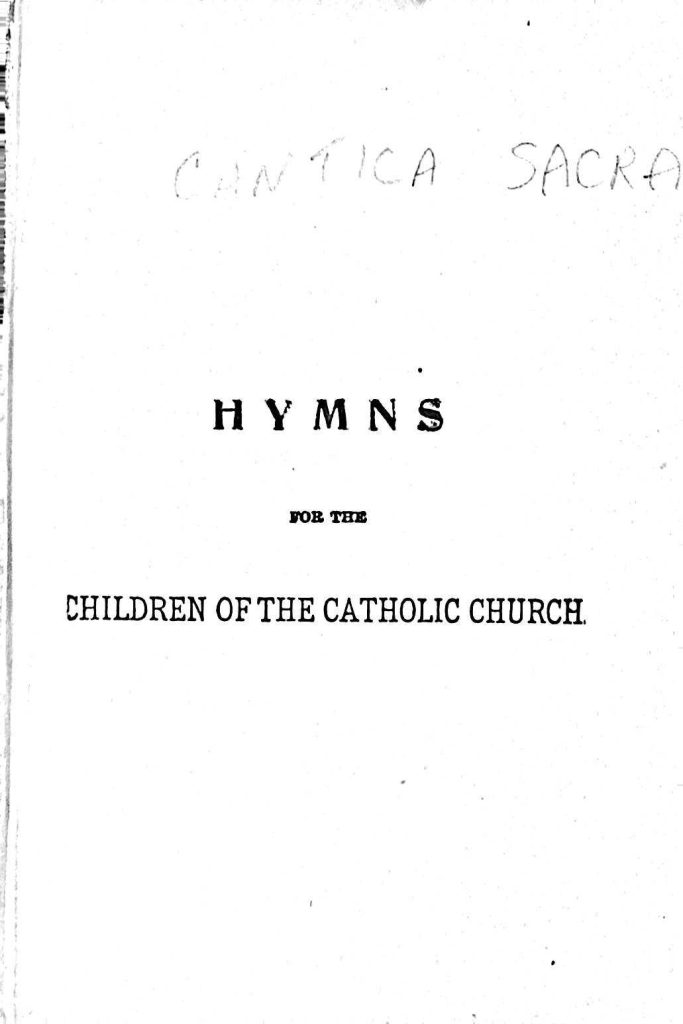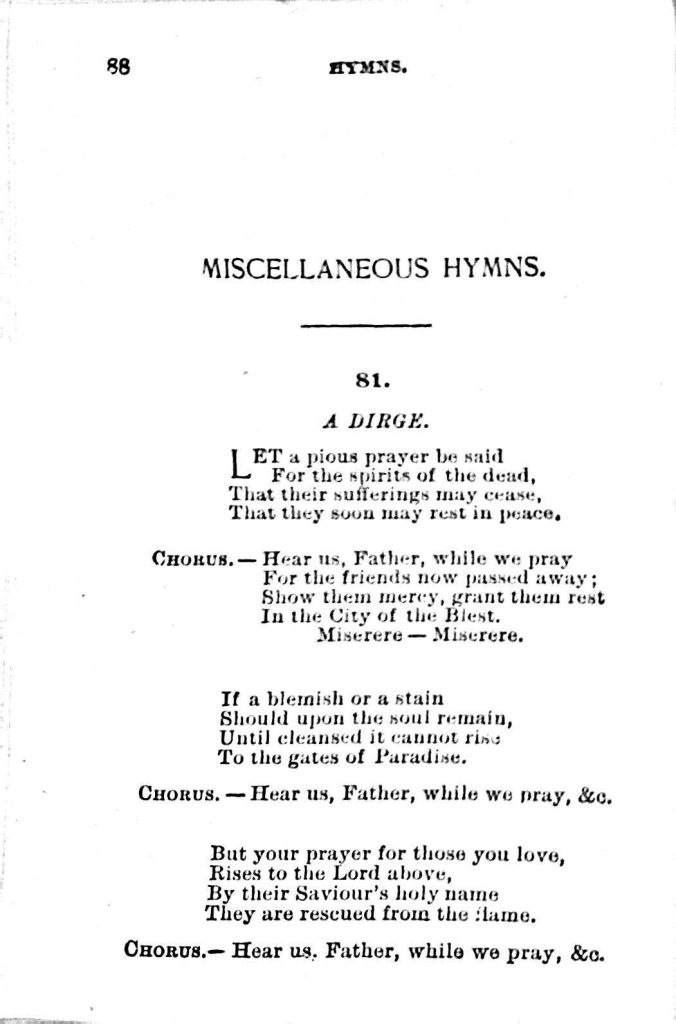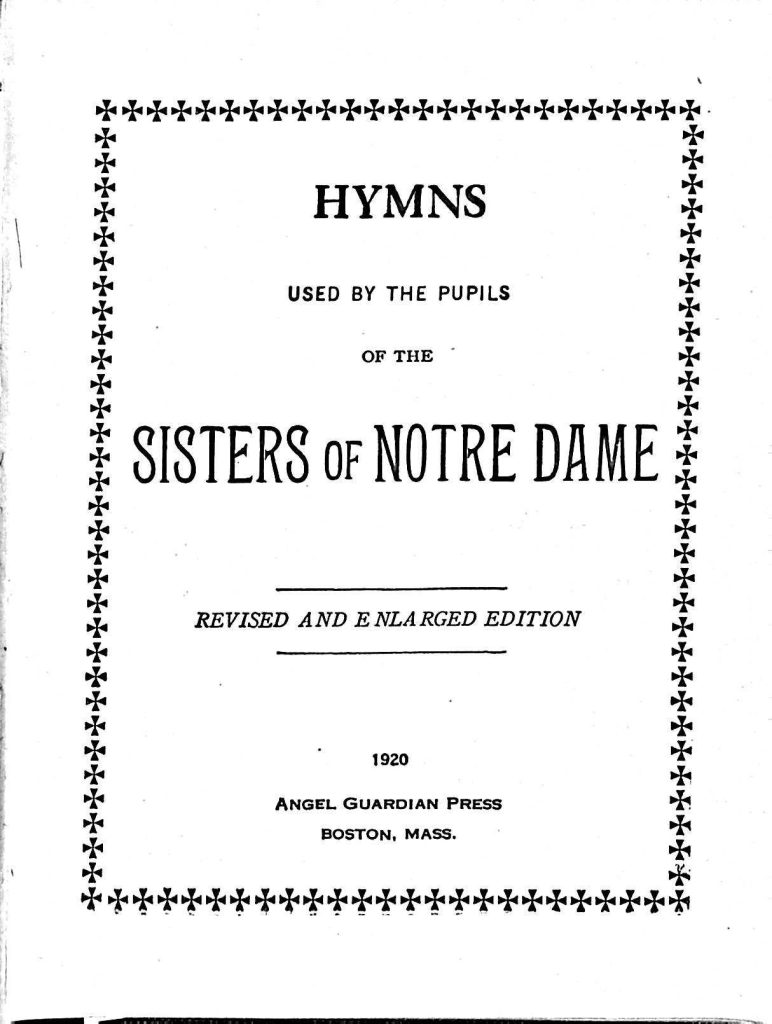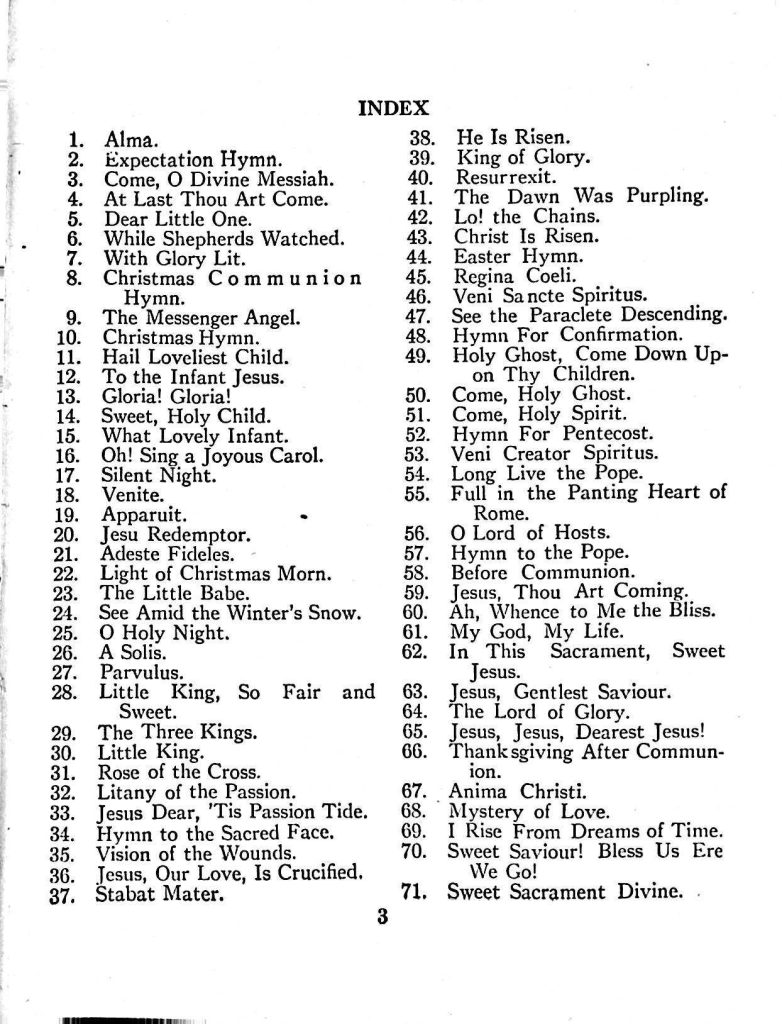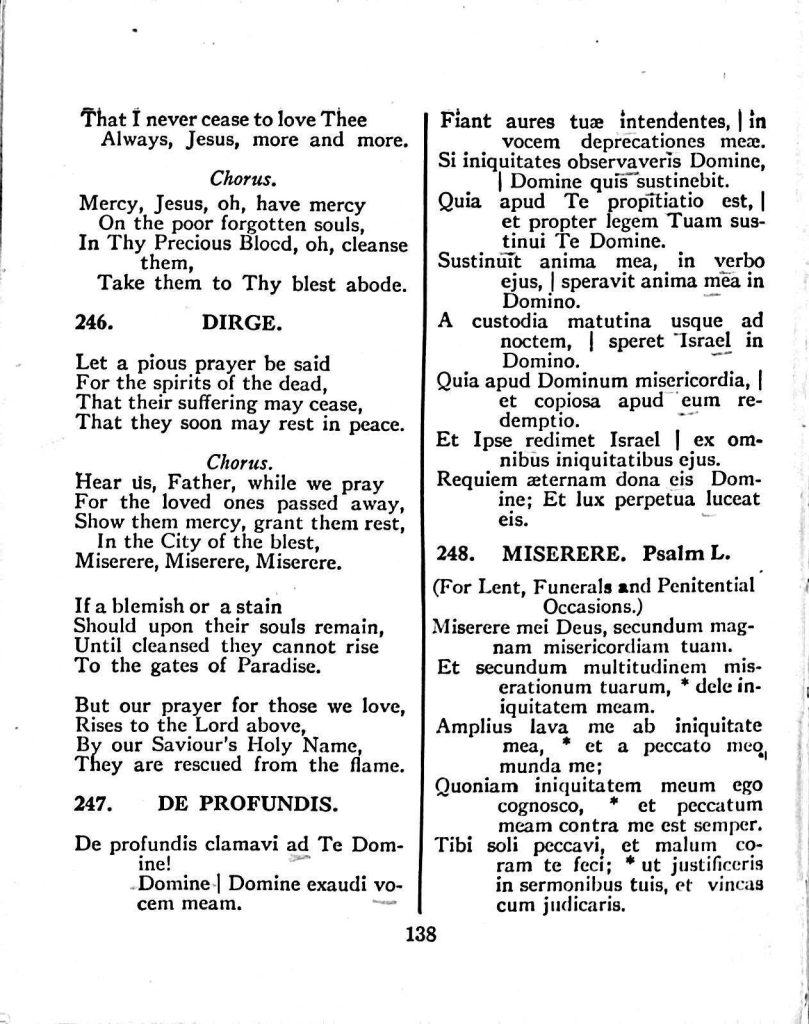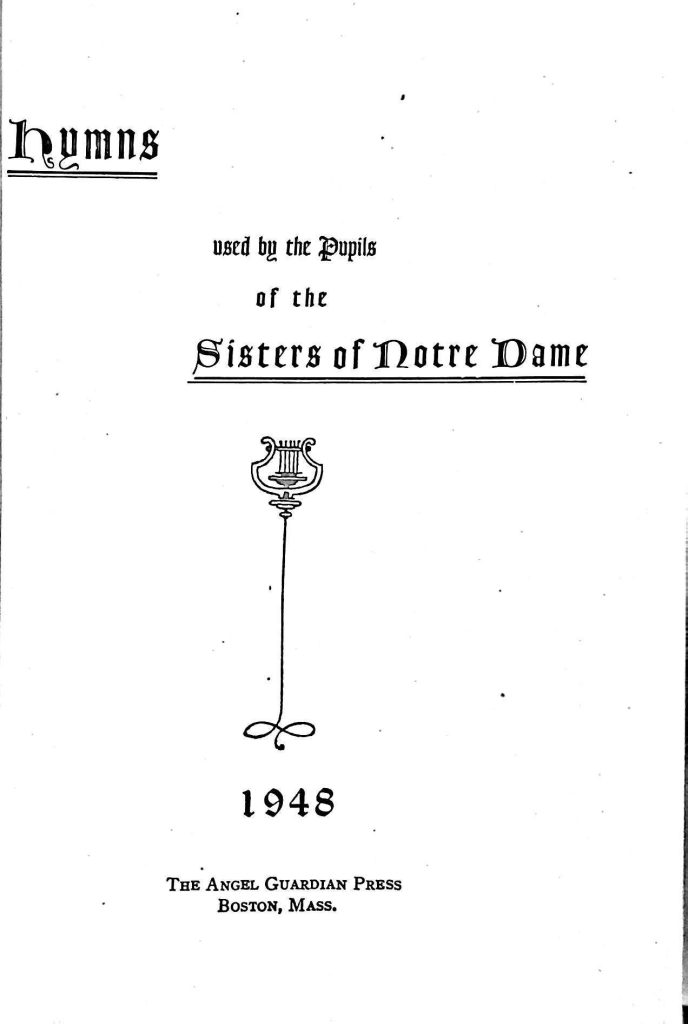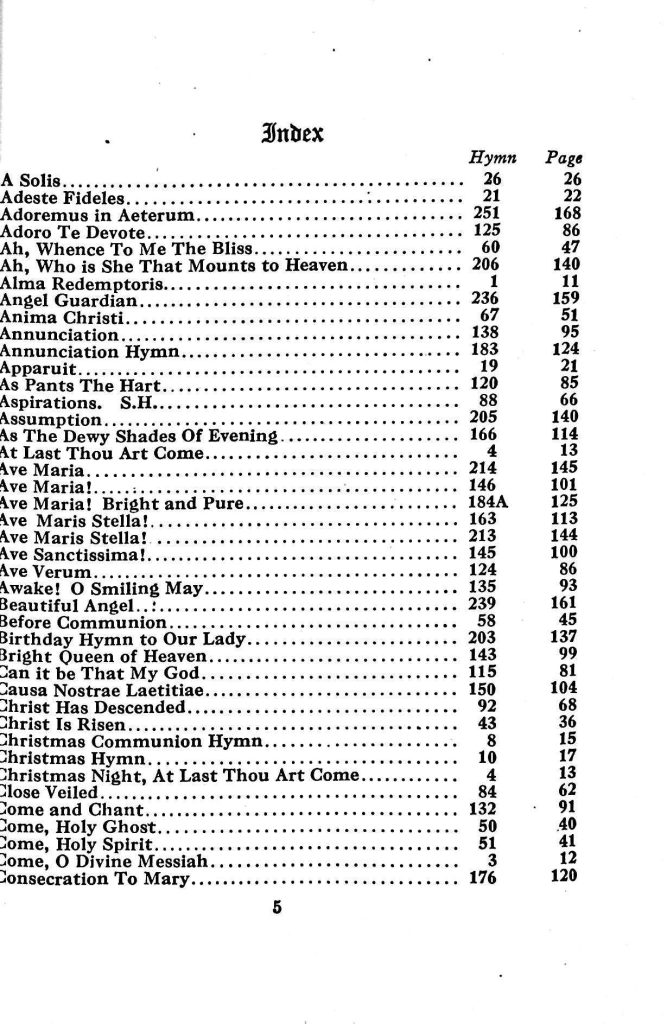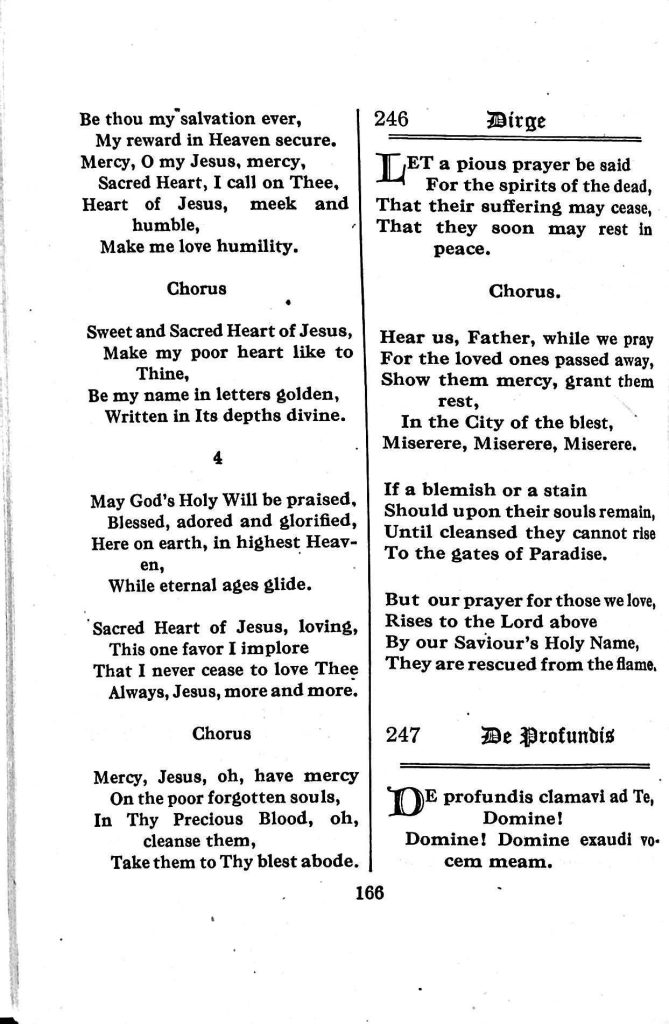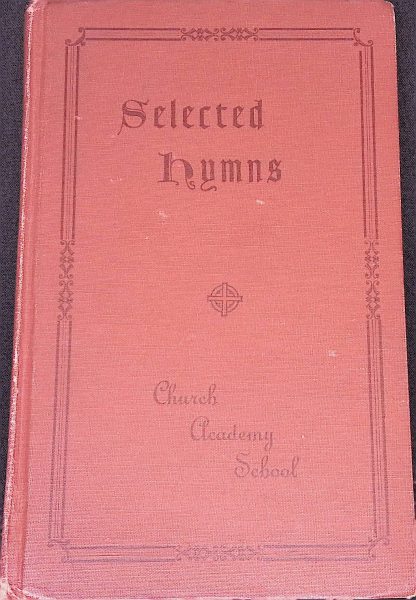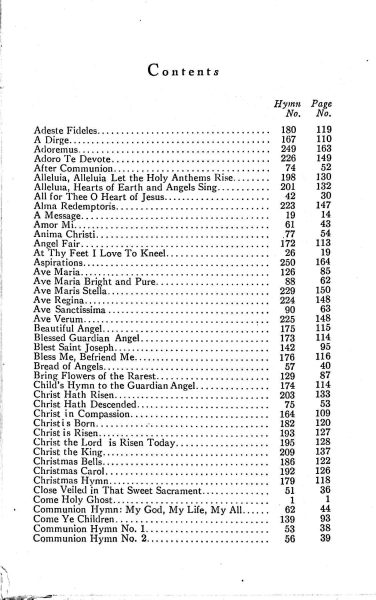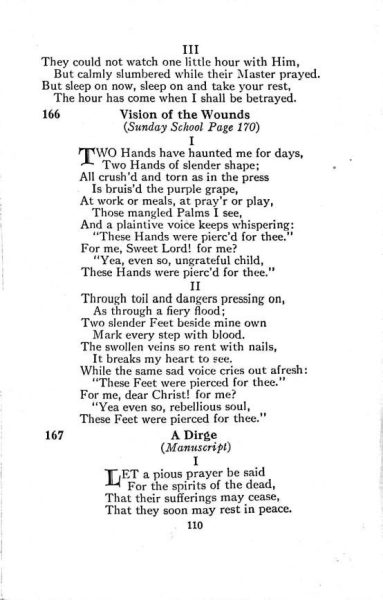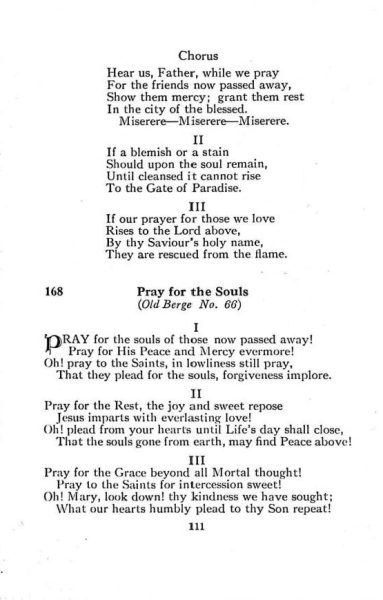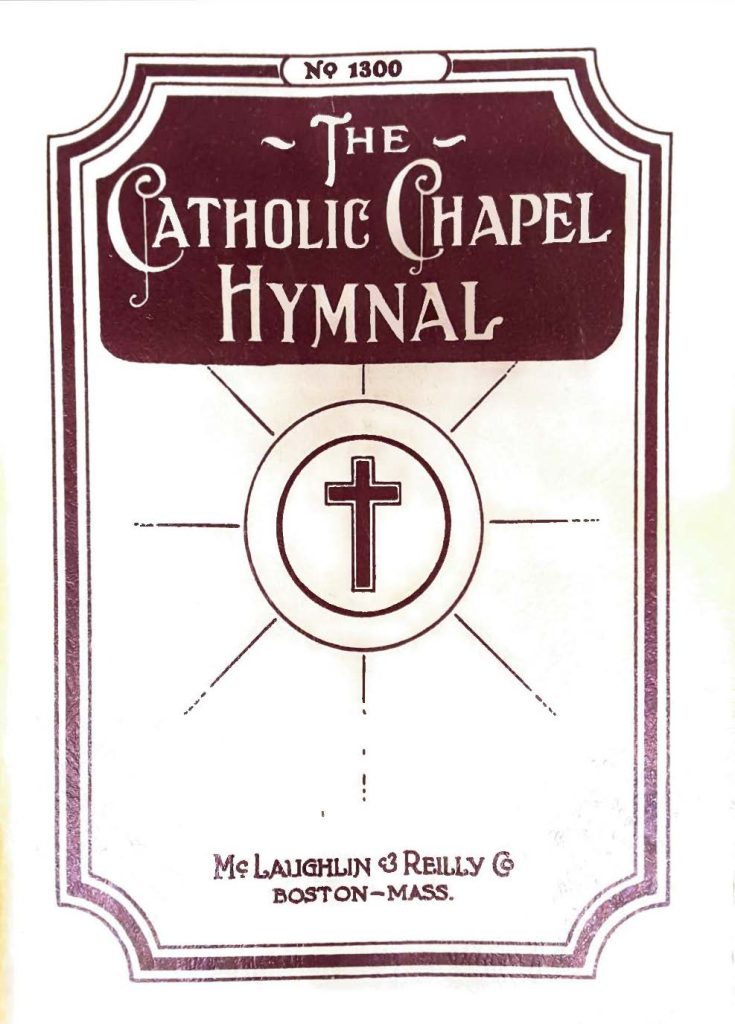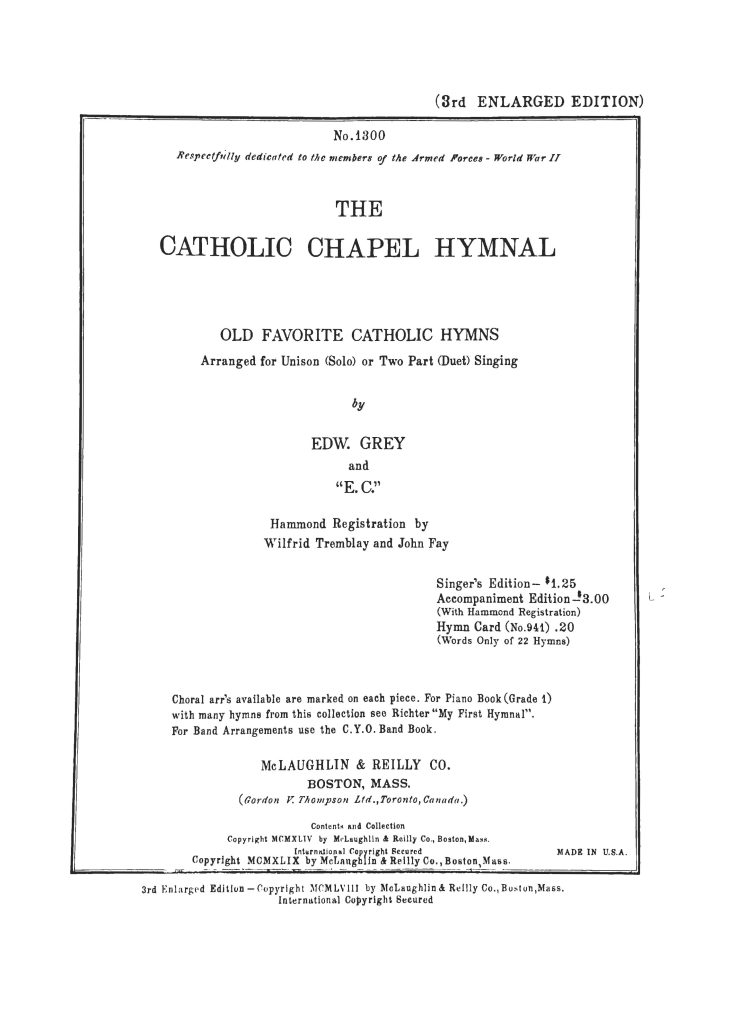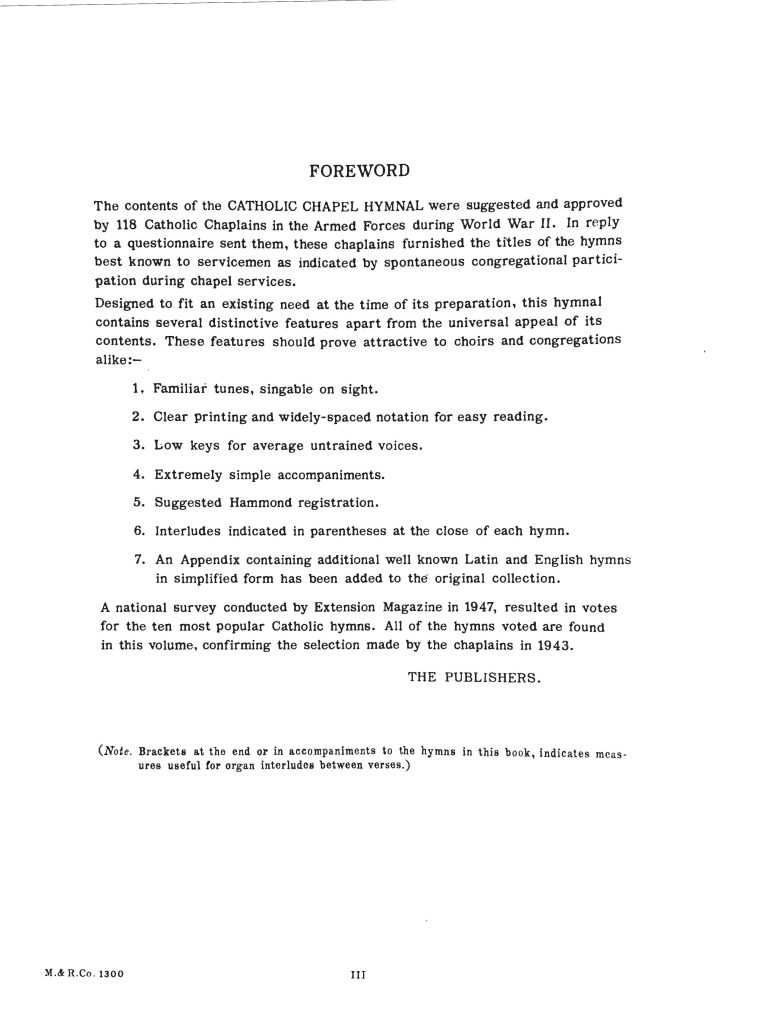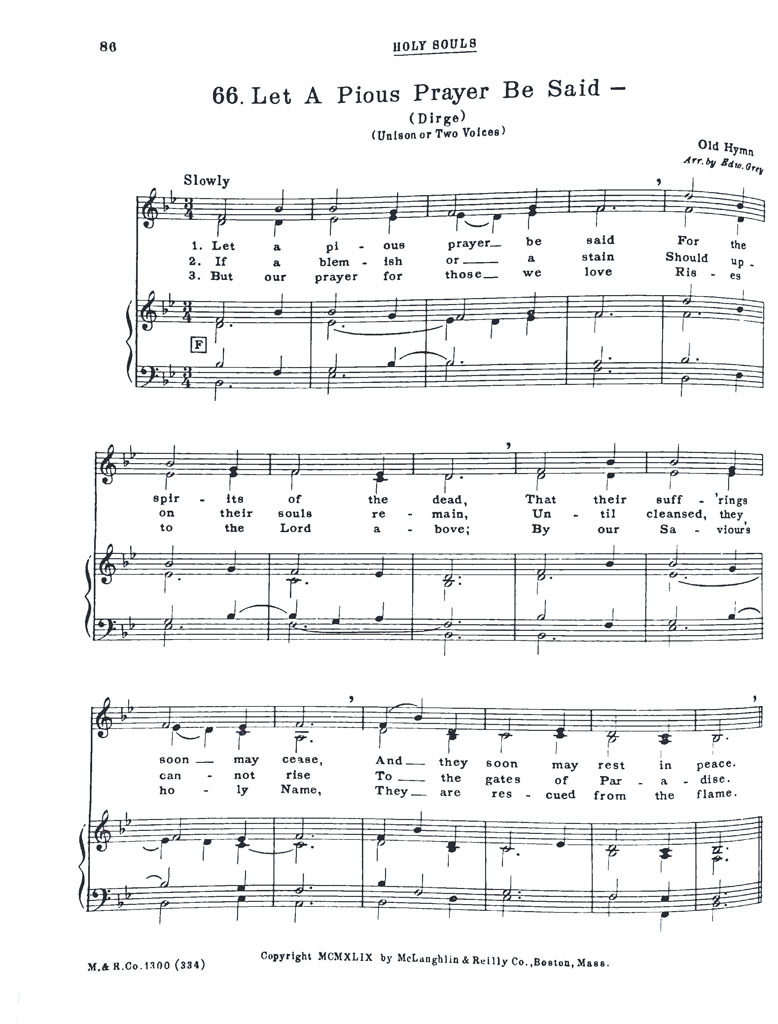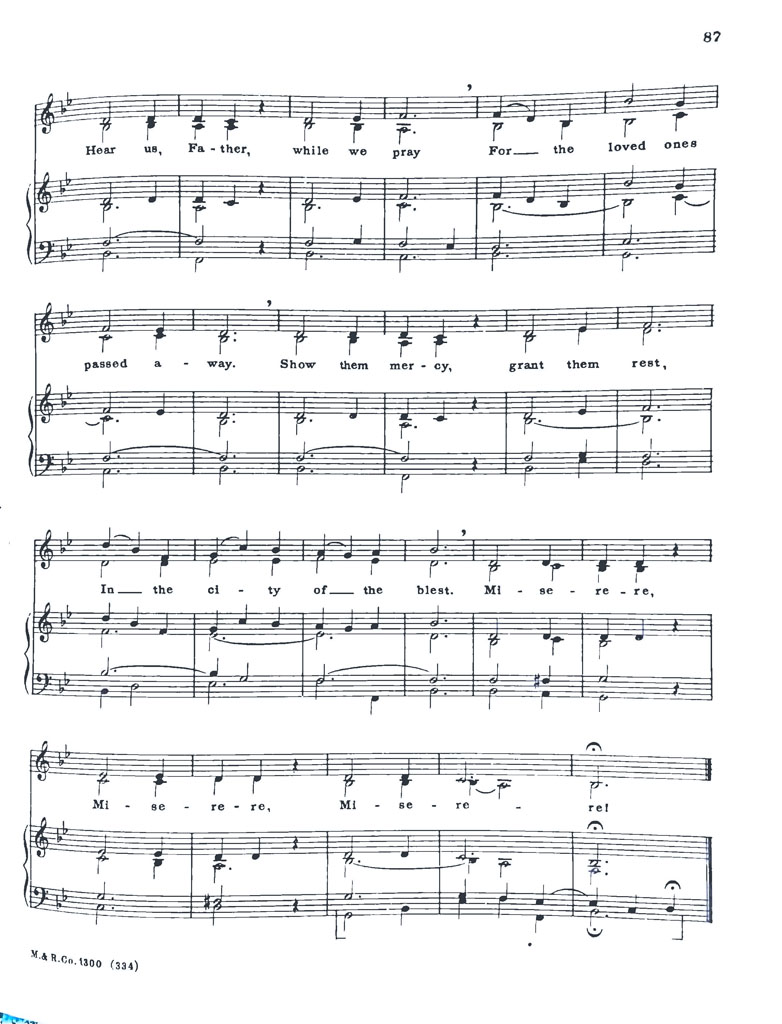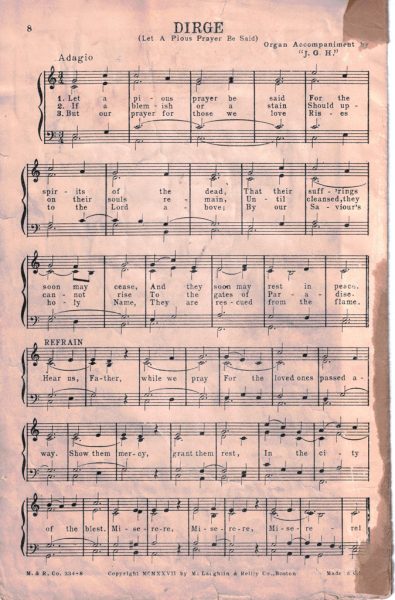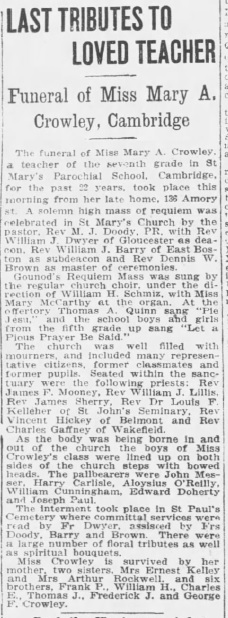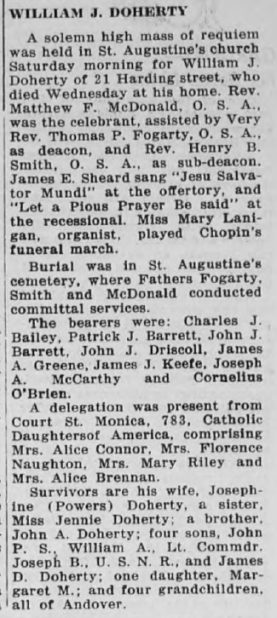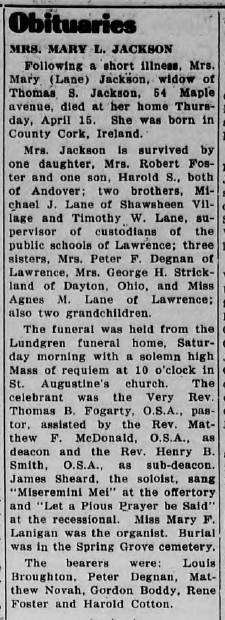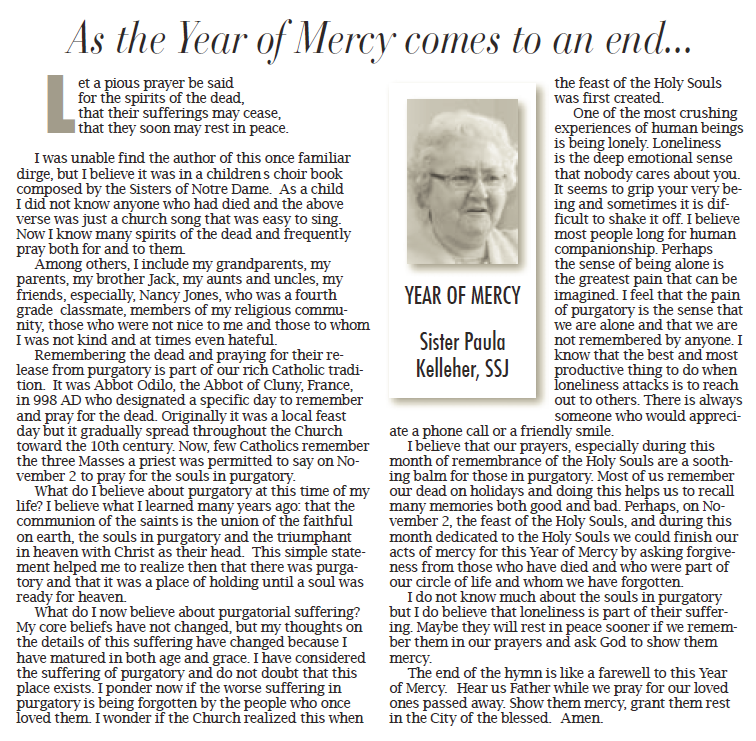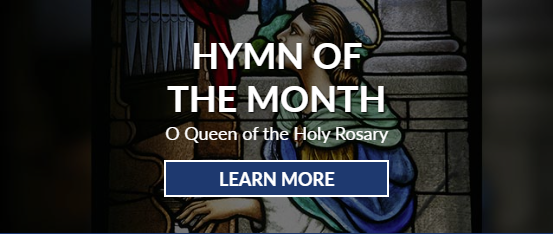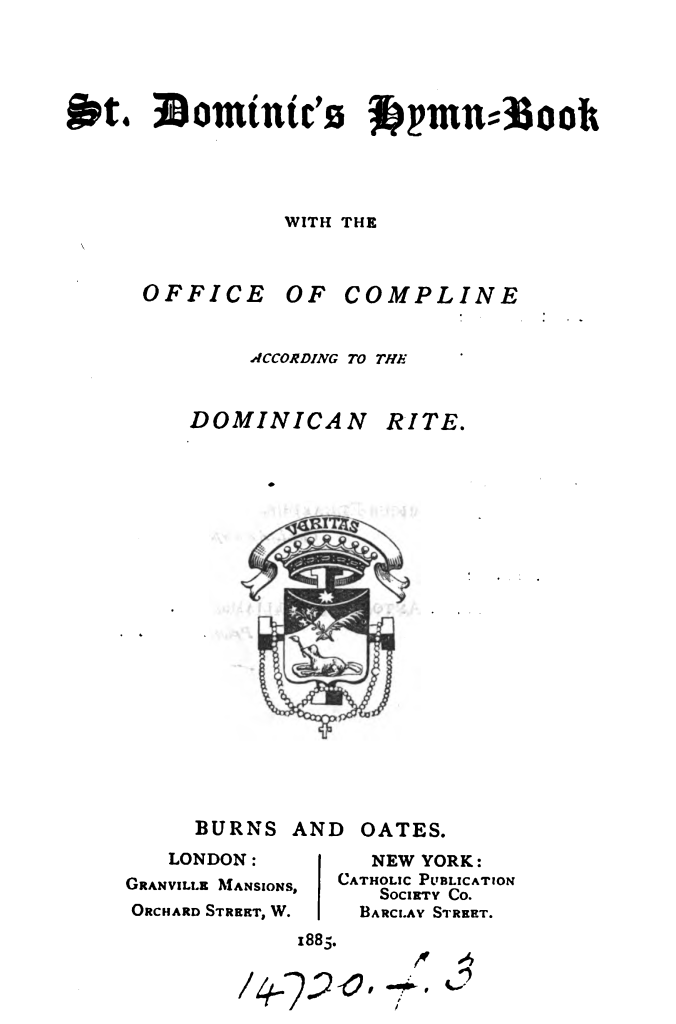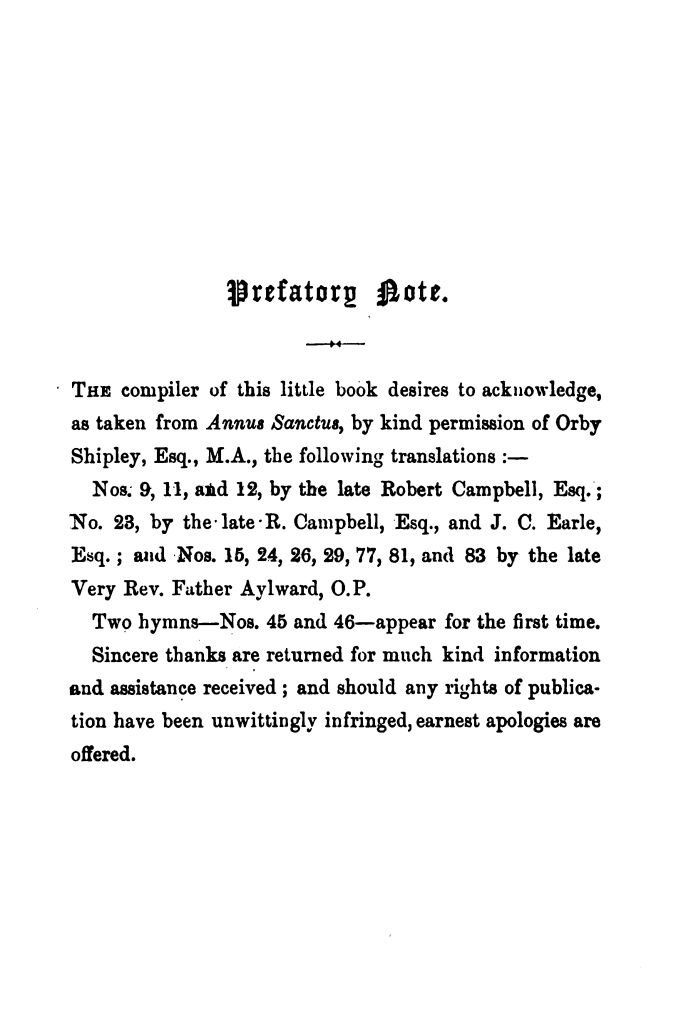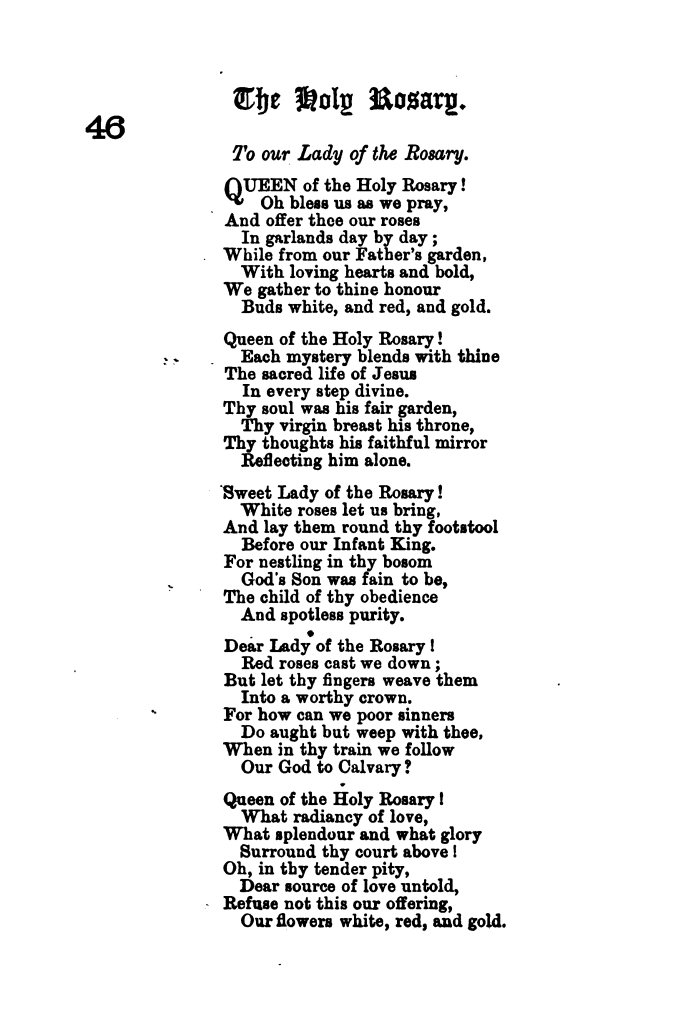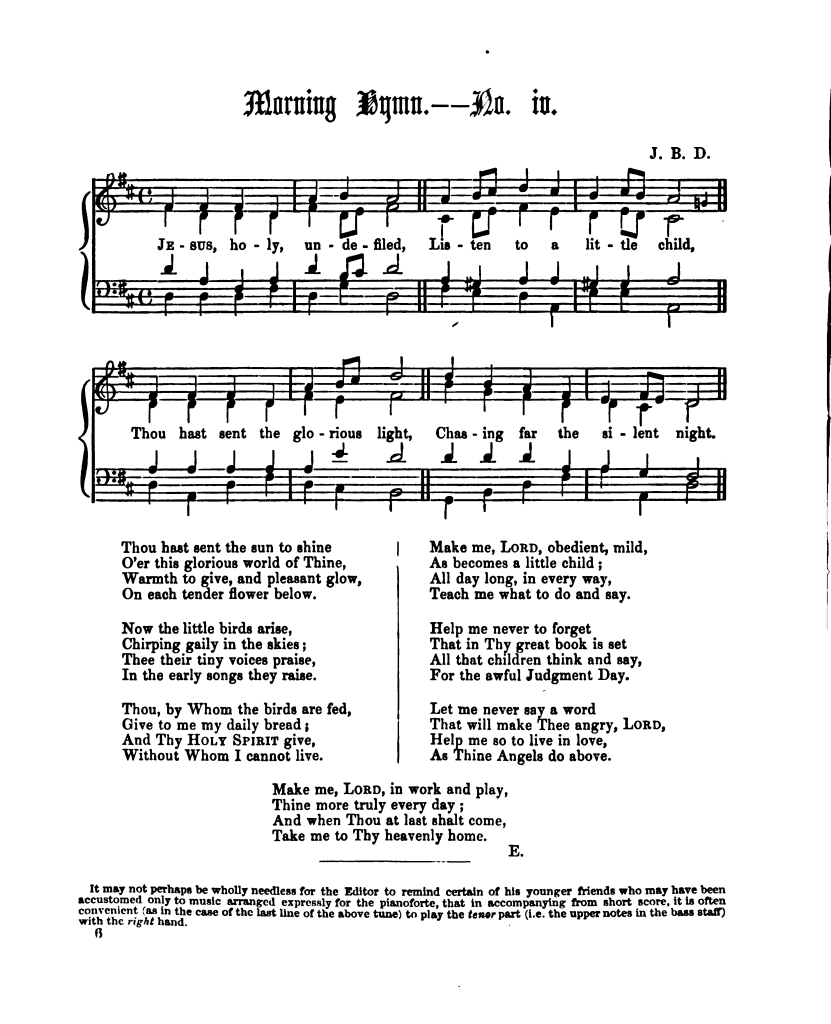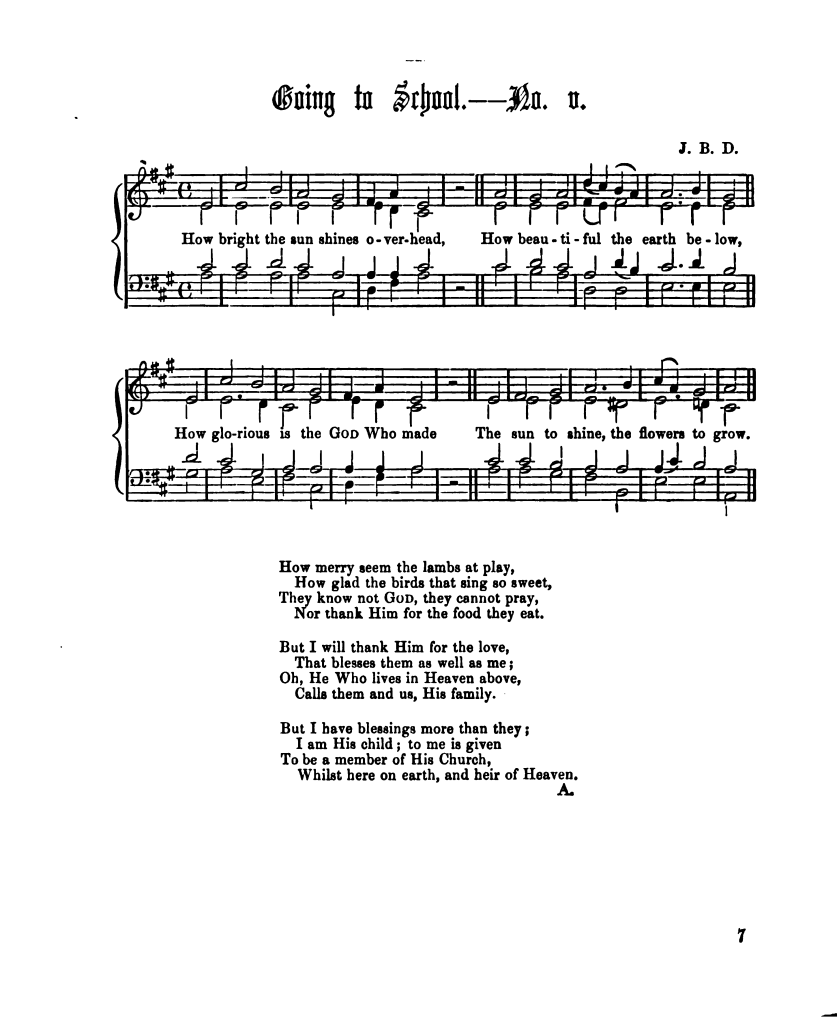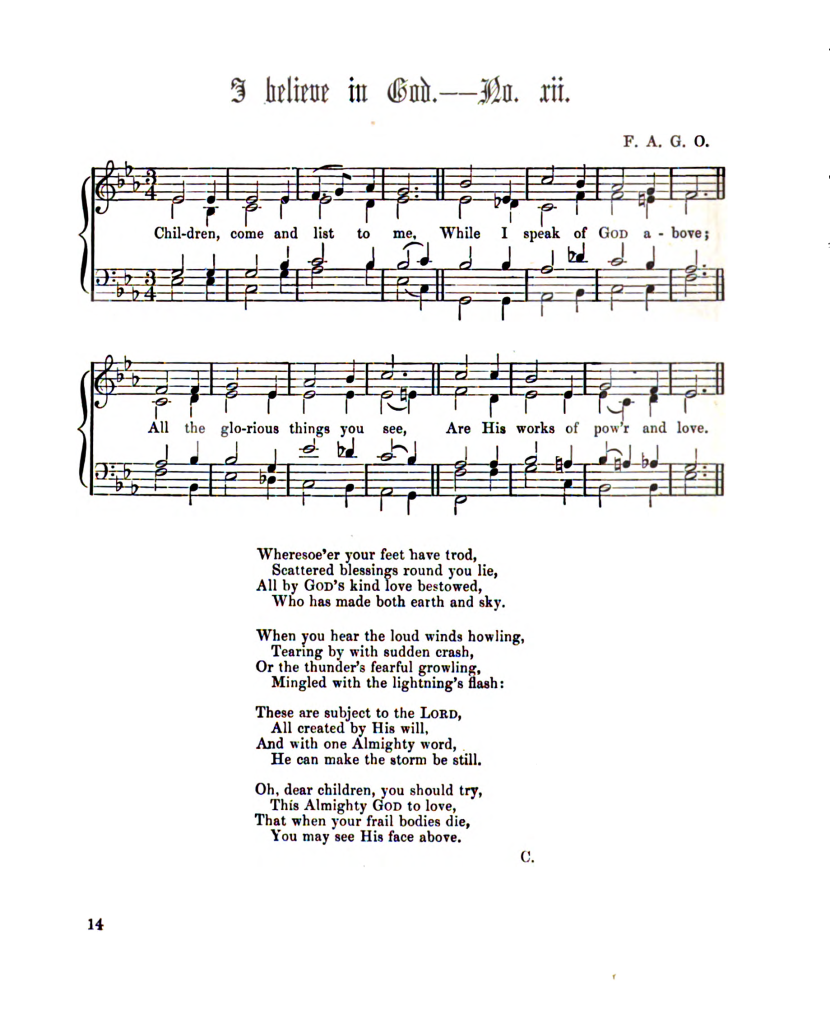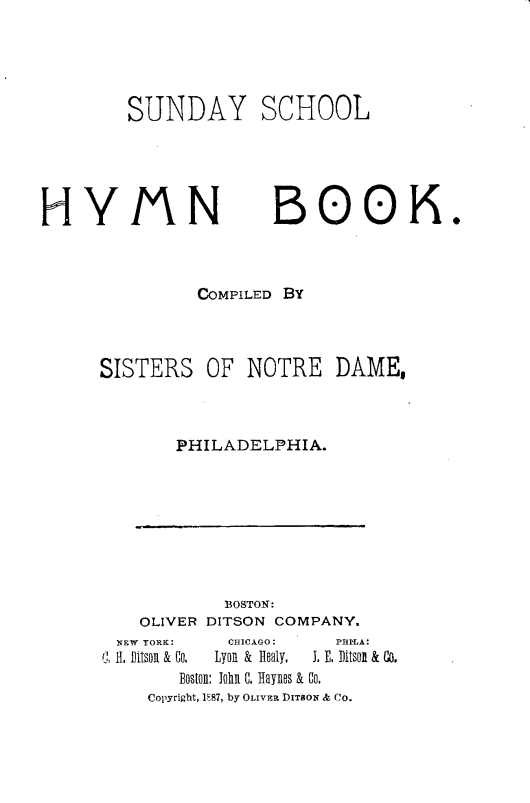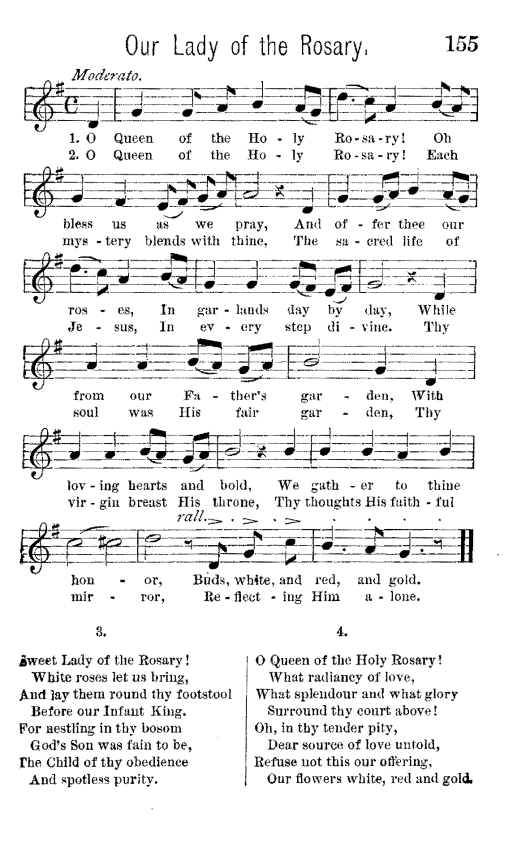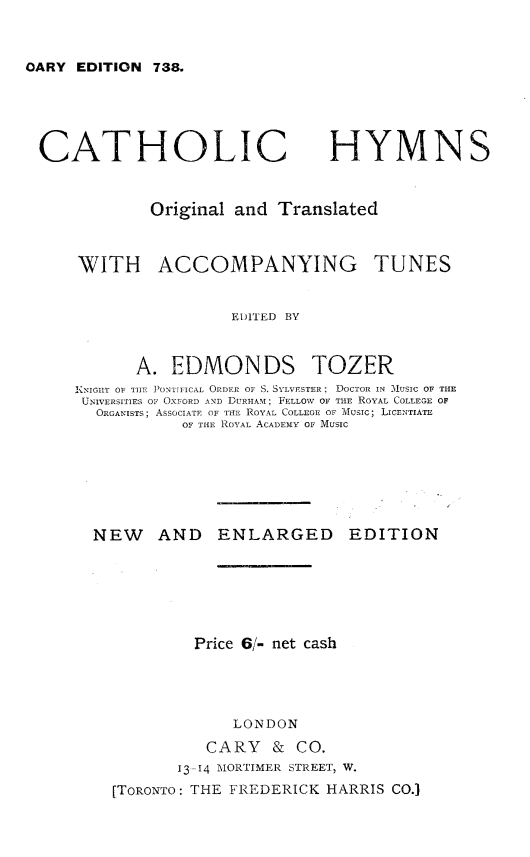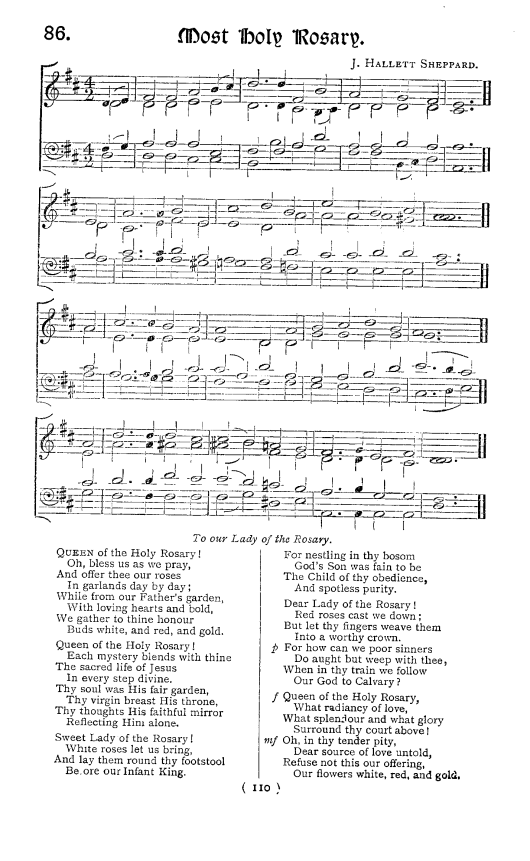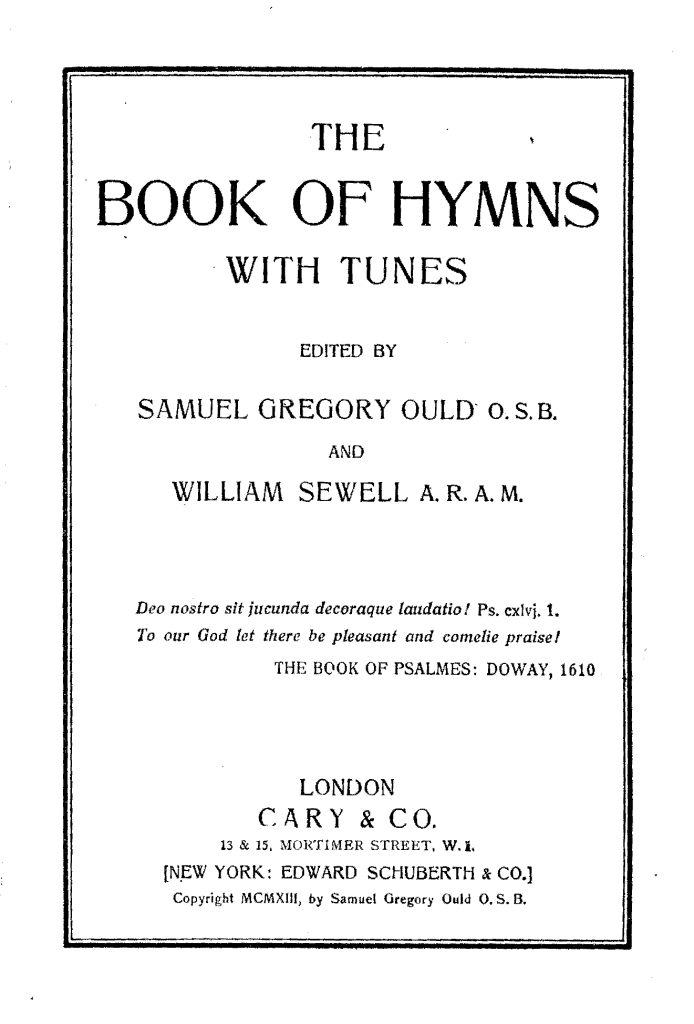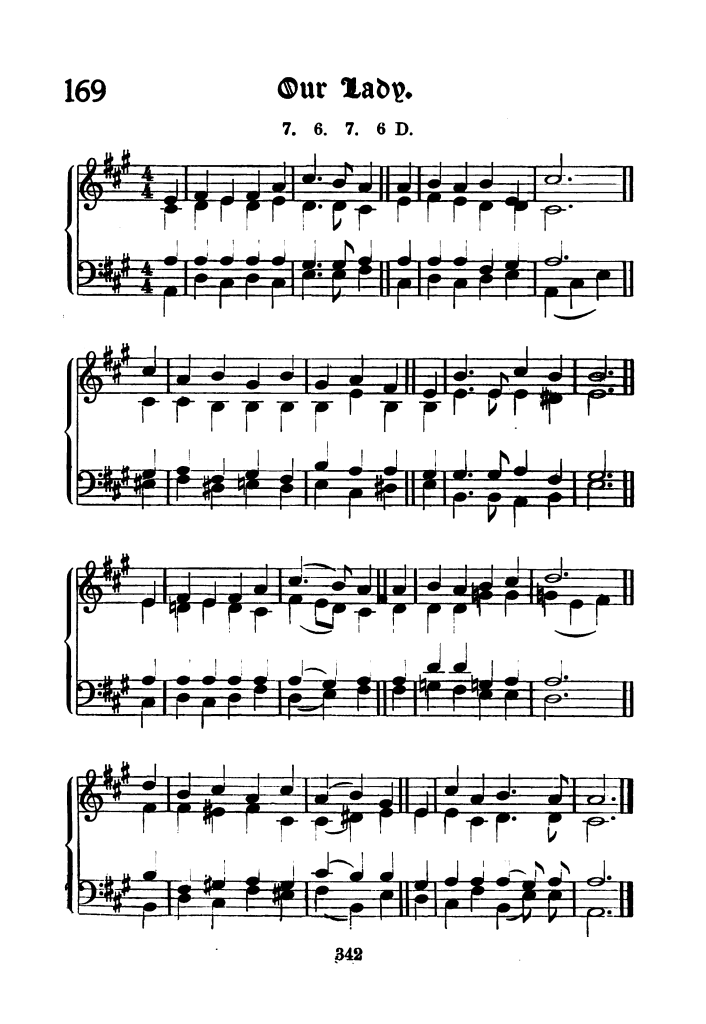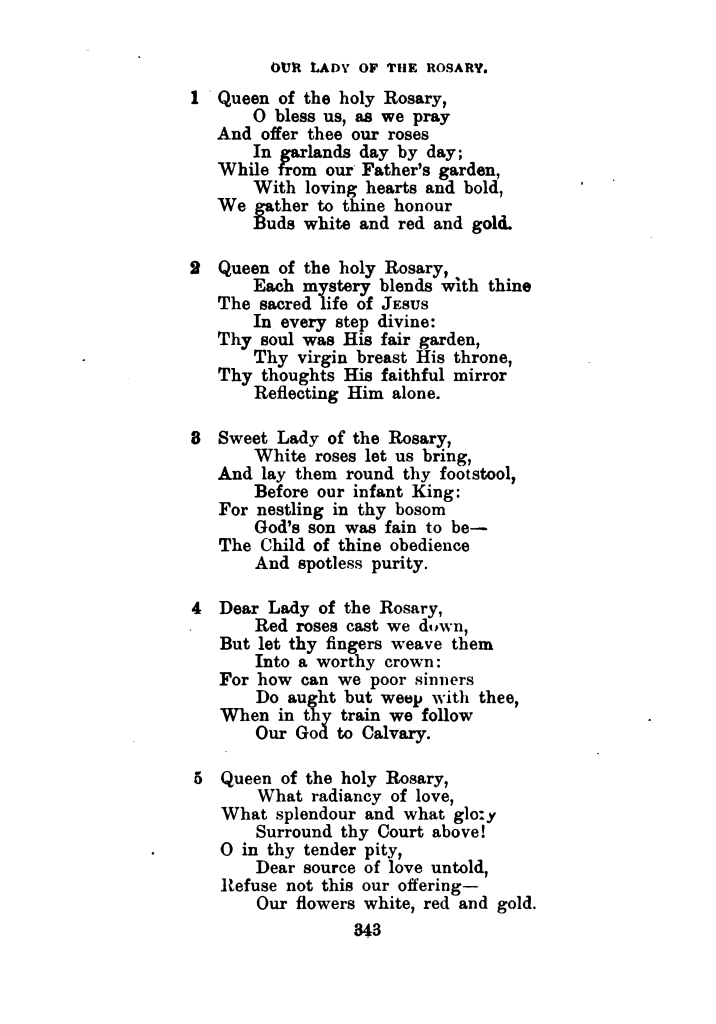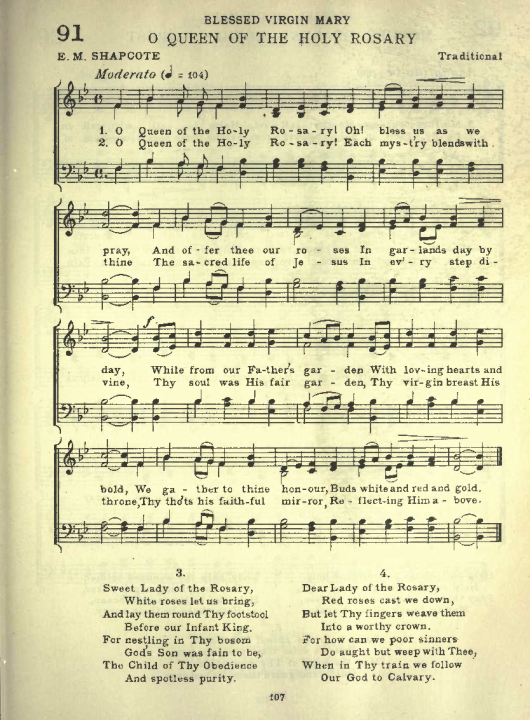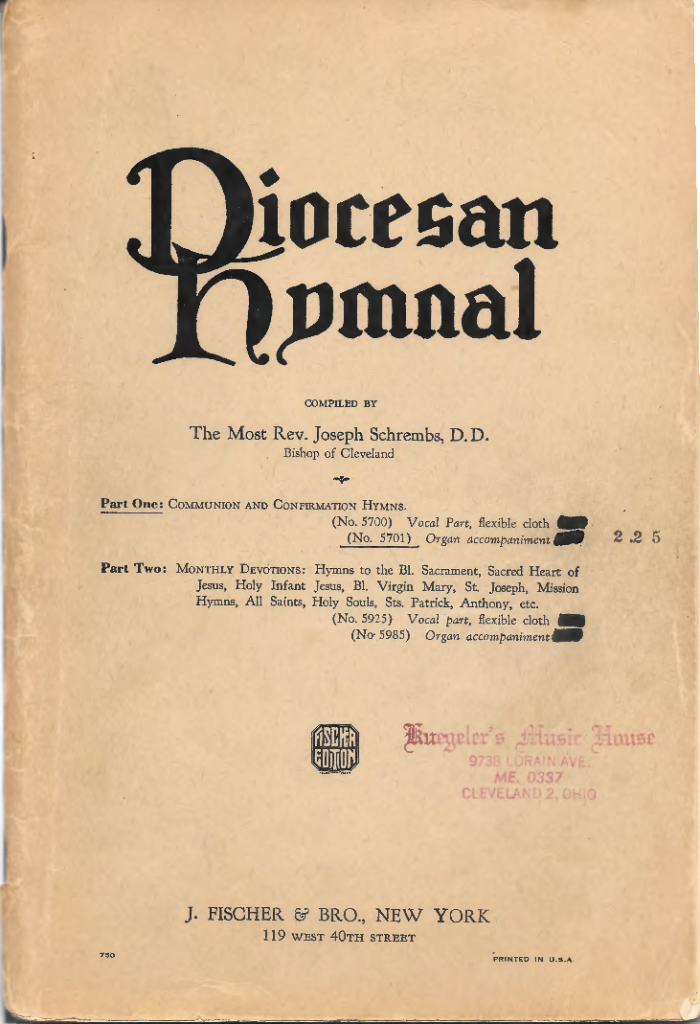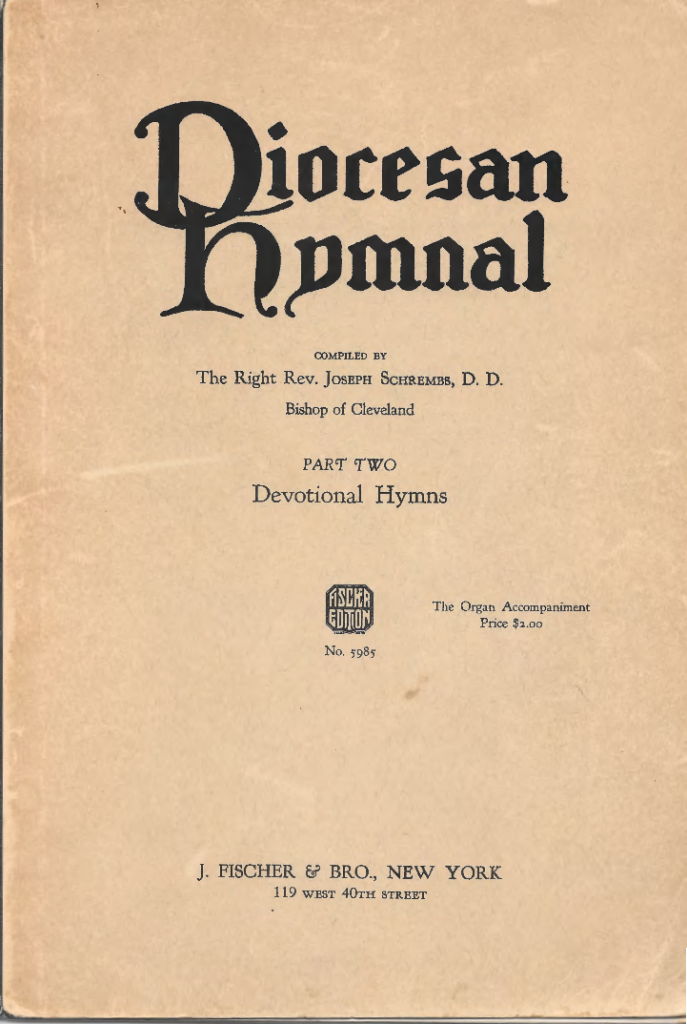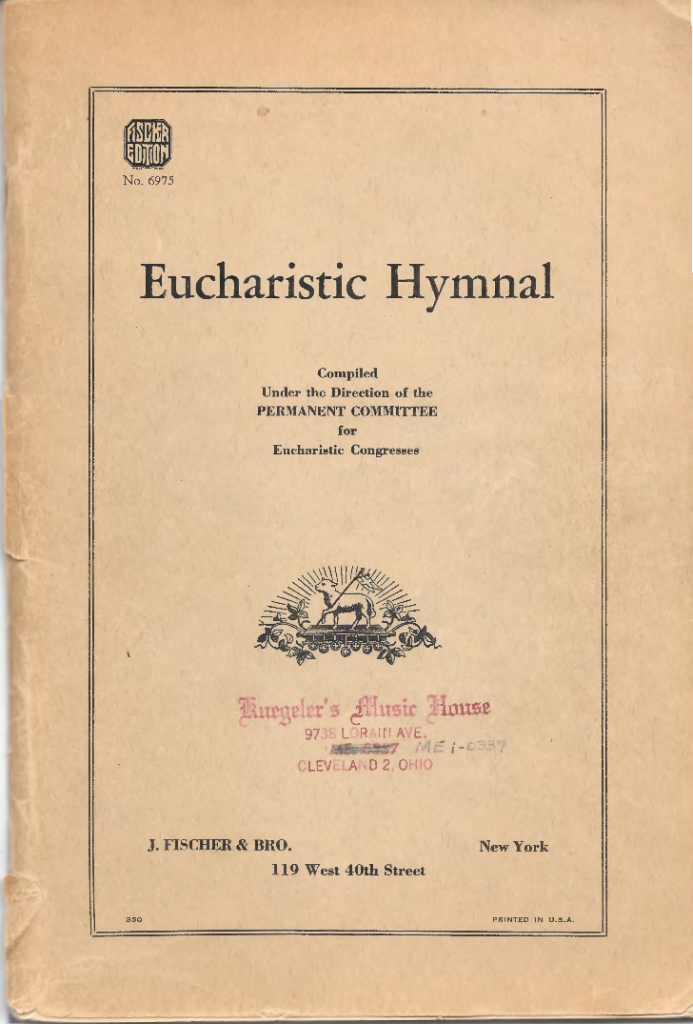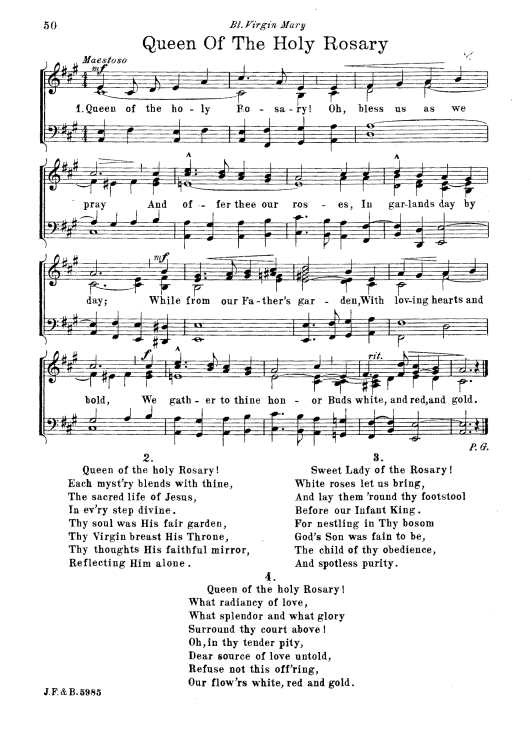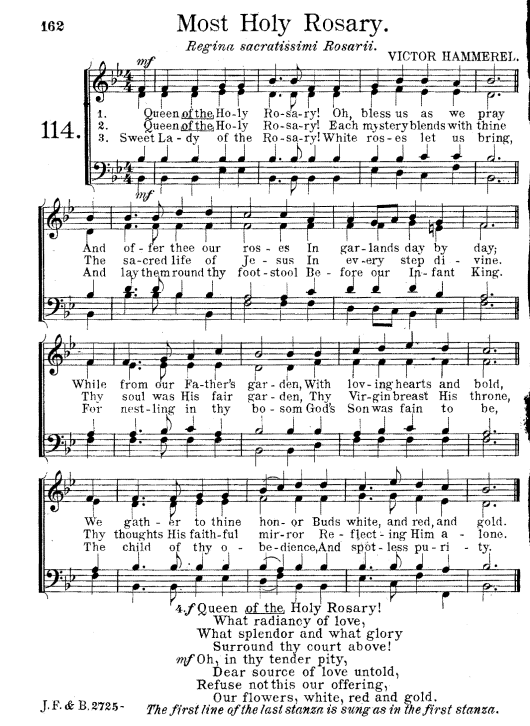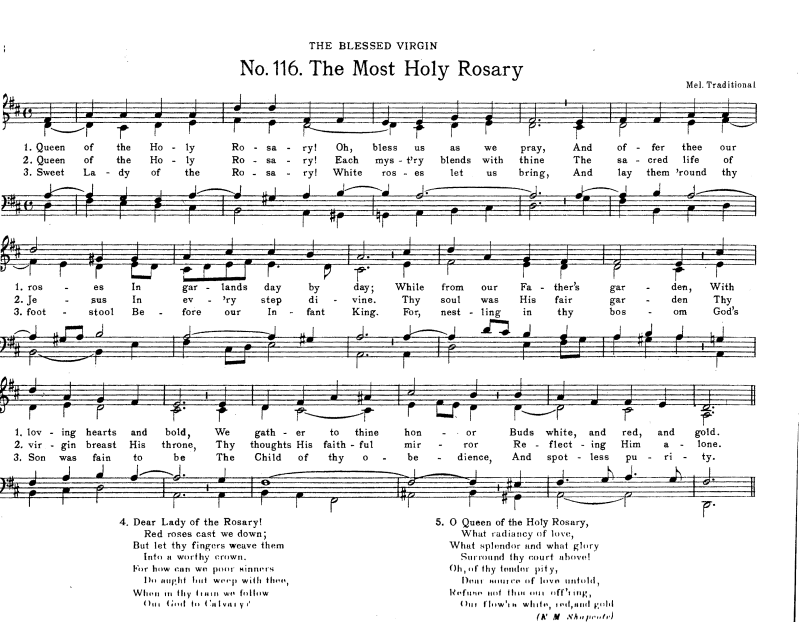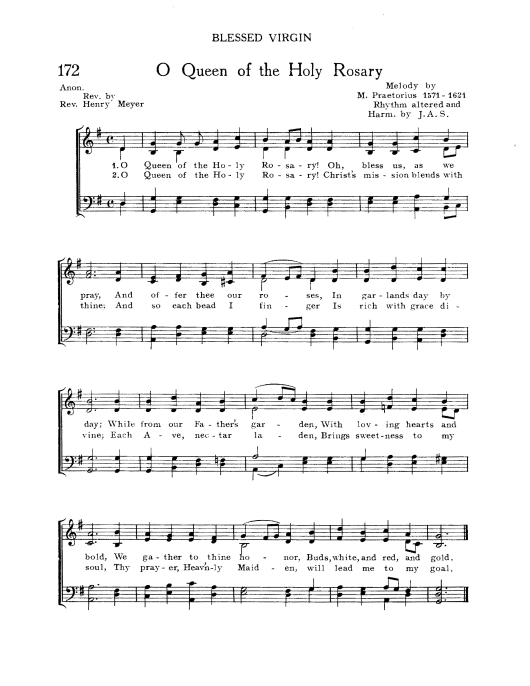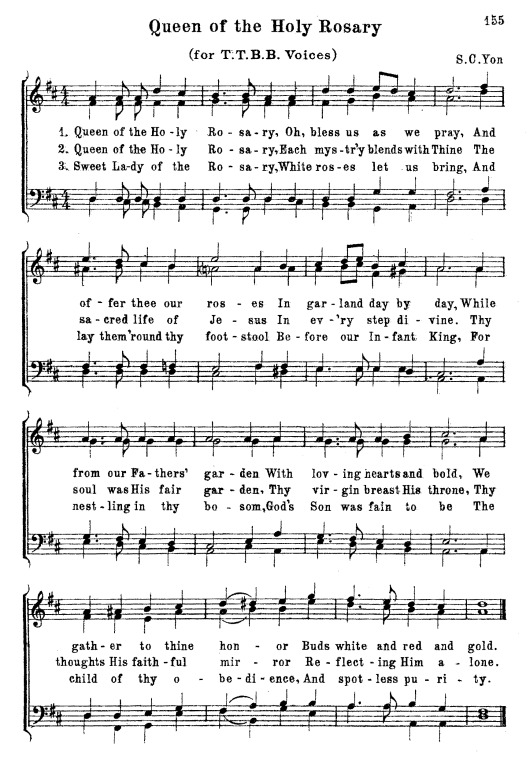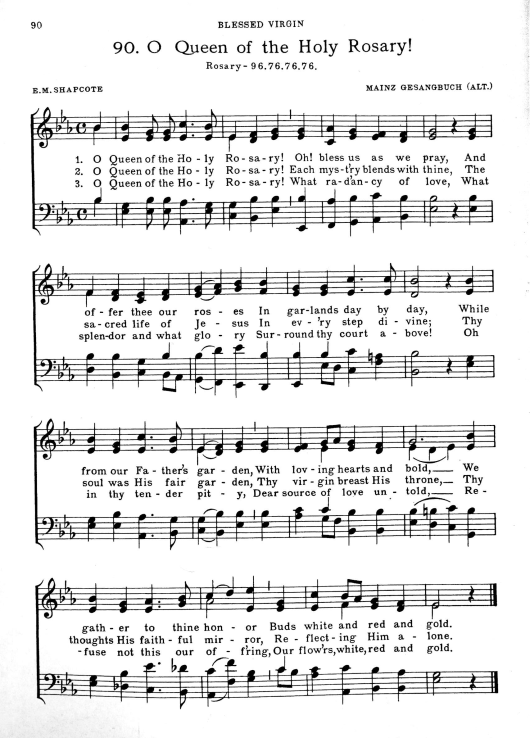Father Jeremiah Cummings, D.D. (1814-1866) wrote the words of this hymn. He was from a family of Northern Irish Protestants who came to the United States and settled in what is now Washington D.C. (ca. 1782). After his birth, his mother converted to Catholicism, and this led to an estrangement with her family. His father died when he was a young boy, and soon afterwards the family moved to New York City. Although they were penniless, he desired to study for the priesthood. Arrangements were made and he became a student of Bishop John Dubois (1764-1842), third bishop of the Diocese of New York and attended Bishop Dubois’s seminary in Nyack.
Through the good graces and the interest of Father J. P. McGerry of the New York Archdiocese, he was accepted at the College of the Propaganda, Rome, in 1834. Little is known about Father McGerry except for a curious entry found in Archives of the Pontifical College in Rome. Entry 21, page 371, gives a brief account of a handwritten letter by Father McGerry to Dr. Paul Cullen written on March 10, 1834 in which he asks for help in the case of a boy of 11 years who is anxious to become a priest but whose parents have not the means to pay the necessary fees. He writes,
I have a boy, the son of a very distinguished convert who is anxious he should study for the Church. The boy is eleven years old and very talented. The mother of the boy since her conversion has been by the gambling and sporting of her husband very much reduced in circumstances. All the family are converts but the husband. The oldest daughter entered a Nunnery at sixteen and is now a professed Sister in the Convent of the Visitation at George Town, District of Columbia. If you aid me to get a place in the Propaganda for the boy alluded to, Jeremiah Cummings, on reduced terms, you will do me a favor and a great good, I hope, to Religion. If not, let me know if there is a place for him, and what will be the lowest terms upon which he can be received.
Jeremiah Cummings successfully completed his studies and gained the degree of Doctor of Divinity. He was ordained on January 3, 1847 and returned to New York City. He was for a brief time assigned as a priest at the old St. Patrick’s Cathedral.
In 1848, Bishop John J. Hughes (1797-1864) the first Archbishop of the Archdiocese of New York, appointed him pastor of the new St. Stephen’s Parish where he oversaw the building of the church and school. Father Cummings had a great fondness for music, and soon took charge of the choir. Oftentimes as was the case, well-known singers from the Metropolitan Opera House joined the choir. Through his influence the choir gained the esteem of the people who came from all over the city to Sunday High Mass. St. Stephen’s Church became one of the largest Catholic parishes of the day with over 28,000 parishioners.
In addition to his priestly duties, Father Cummings found time to author a couple books including Italian Legends published in 1858, and Spiritual Progress published in 1865. He contributed articles to Appleton’s Encyclopedia and Brownson’s Quarterly Review.
He published a hymnal of his own compositions, SONGS FOR CATHOLIC SCHOOLS. Two editions were published, the first was published by J. O’Shea in 1860, and the second edition by J. & D. Sadlier in 1862. Father Cummings hymnal is significant in the annals of Catholic hymnals as being in his own words, the first of its kind, and until 1860, the only Catholic collection of original hymns by an American author. (Click on any image to enlarge)
In the 1860 July issue of the Brownson’s Quarterly Review which was mistakenly identified by J. Vincent Higginson as the 1863 Brownson’s Review in his History of American Catholic Hymnals Survey and Background, the editor gives an account evaluating the hymns as All the Songs, with one exception, are by Dr. Cummings, and though not all of equal merit, they all indicate poetry of a high order, and breathe the true spirit of Catholic faith and piety. The music by Signor Speranza is simple, yet rich , and we shall be much mistaken if several of his airs do not become naturalized and enter into the list of our national airs .
The editor’s remark that All the Songs, with one exception, are by Dr. Cummings, deserves mention because future publishers of English and American Catholic hymnals including DOM Ould’s Book of Hymns with Tunes, Dr. Terry’s Westminster Hymnal, the Holy Name Hymnal, the De La Salle Hymnal, and the American Catholic Hymnal would mistakenly identify the author of certain hymns as other than by Father Cummings.
This fact was brilliantly illustrated in a paper that appeared in the 1915 July issue of The Catholic Historical Review – A Forgotten American Hymnodist by Monsignor Hugh Thomas Henry (1862-1946). Three hymns were specifically mentioned in this paper:
- Great God, whatever through Thy Church
- O brightness of Eternal Light
- Hail, Virgin of Virgins
The Hymnals
The hymn Let A Pious Prayer Be Said appeared in only a few Catholic hymnals. These are the CANTICA SACRA published in 1865 and 1880; the YOUTH’S MANUAL FOR CHURCH AND SCHOOL, 1885 and 1908 editions; HYMNS USED BY THE PUPILS OF THE SISTERS OF NOTRE DAME, 1921 and 1948 editions, SELECTED HYMNS ca. 1930s, and THE CATHOLIC CHAPEL HYMNAL, 1958. Sometimes the hymn is listed as Dirge or A Dirge and others by the first line of text.
The CANTICA SACRA, or Hymns for the Children of the Catholic Church, first appeared as a word only edition in 1865, and the texts was compiled by Bishop John B. Fitzpatrick of Boston. This was followed by the musical edition with all original tunes compiled by Father John H. Cornell of Boston College and published by Patrick Donahoe in 1865. The hymnal contains hymns by Father Cummings, Father Faber, Father Caswall, and some translated hymns by St. Alphonsus Ligouri.
A third edition of the CANTICA SACRA was then published by Thomas B. Noonan & Co., of Boston in 1880. In this edition, attributions are given to J. Frank Donahoe, organist at Holy Cross Cathedral, Boston and the Sisters of Notre Dame, for their musical arrangements. A few of the tune are of German origins for example Holy God, we praise thy name. The musical editions do not include the hymn Let a Pious Prayer Be Said, probably because it was listed as a miscellaneous hymn.
The YOUTH’S MANUAL FOR CHURCH AND SCHOOL is a small collection of hymns, prayers, and Catechism, first published in 1885 by J. L. Spalding, then again in 1908 by Thomas J. Flynn & Company of Boston. The hymn section of this hymnal, a word only collection, is often referred to as the Cantica Sacra and contains three parts.
The first part is captioned Hymns for the Children of the Catholic Church and is essentially a reprint of the hymns found in the CANTICA SACRA. The second part contains Miscellaneous Hymns, there are about twenty, which do not appear in the musical edition. The third part is captioned Hymns, there are thirty-eight and they are not numbered but indicate the music can be found in other collections. For example, the hymn Children of the Heavenly King, refers to Rohr’s Catholic Melodies, page 61.
HYMNS USED BY THE PUPIL’S OF THE SISTERS OF NOTRE DAME is significant because the Sisters of Notre Dame de Namur who originally came from Belgium in 1840, were among the first of the religious order of nuns to established schools and academies in the United States beginning in Cincinnati, Ohio. These vest-pocket word-only hymn collections were published in 1920 and again in 1948 by The Angel Guardian Press. In the 1920 edition, the hymns are listed numerically. The 1948 edition, which is essentially a reprint of the 1920 edition, corrected the listing of hymns to be alphabetical and included the hymn number and page number.
A good number of the Sisters of Notre Dame wrote hymns for the school children and a demand for the hymns used by the Sisters grew as students graduated and moved to other parts of the country. Carrying these hymns in their hearts, the students passed them on to future generations. Eventually, publishers like W. C. Peter’s, the Oliver Ditson Company, and McLaughlin & Reilly published collections of these hymns in hymnbooks. Though many of the hymns by the sisters have fallen silent, a few still remain and are popular among Catholics today.
On an aside, among the other religious order of nuns who established schools and academies across the United States were the Sisters of Mercy arriving in 1843, and the Sisters of St. Joseph arriving around the same time.
SELECTED HYMNS is a small word-only book of hymns that was probably developed by the Sisters of St. Joseph of the Archdiocese of Boston according to hymnologist Peter Meggison producer of The Devotional Hymns Project. There is no date of publication or name of the editor, however, the hymns refer to existing hymnals of the day for the music such as St. Basil’s, the Chapel Hymnal S.N.D., the Standard Catholic Hymnal, Berge’s New Catholic Hymn Book, Father Curry’s Hymnal, the Sacred Heart Hymnal, and others.
Some of the hymns, list publishers or authors like R.S. Morrison Pub.: Presser Co., Phil.; A Sister of St. Joseph; Clarence E. Reed – White Smith Music Company; Mellyn and Horgan; Rev. M. O’Flaherty, and others simply as Manuscript. It has been an interesting challenge to try and date this little hymn book to say the least. Most of the hymnals referred to in this collection were published before or around the 1930s.
THE CATHOLIC CHAPEL HYMNAL is one of the most important contributions to Catholic hymnody published during the 20th century. The contents of THE CATHOLIC CHAPEL HYMNAL were suggested and approved by 118 Catholic Chaplains in the Armed Forces during World War II. The Chaplains replied to a survey conducted by McLaughlin & Reilly Company, a premier Catholic music publishing company of the 20th century period. The survey requested the titles of the hymns best known by service men and women that resulted in spontaneous congregational singing during chapel services. The first edition was published in 1944 with later editions in 1949, 1958 and 1968.
The hymn also appeared in a 1927 Hymn Pamphlet published by McLaughlin & Reilly, Co. It is the same melody but arranged for four voices by J. G. H. I could not find any information on this composer with the exception of his arrangements for Father Curry’s hymn Good Night, Sweet Jesus which include an SATB and a Tenor I-II – Bass I-II.
The Melodies
John M. Loretz, Jr. (1840-1912), organist at St. Peter’s Church, Brooklyn, New York composed the melody for this hymn, shown at the begining of this write-up, and as far as I can determine it is the only melody for this hymn. His initials J.M.L., are found throughout Father Cummings hymnbook. According to the Cyclopedia of Music and Musicians (1889) Vol. 2, page 484:
He was born in Mühlhausen, Alsace in 1840, and came to the United States as a child. In 1857, he went to Paris, France and studied at the Paris Conservatorie. He returned to the United States in 1860 and made his début as a pianist for the Brooklyn Philharmonic Society. He was a conductor at the Park Theatre in New York, and bandmaster in the United States Navy. Some of his works include The Pearl of Bagdad, an opera, given in the Brooklyn Lyceum in 1872; he composed several Symphonic overtures; Masses; Episcopal Church services, Sonatas, and other music for pianoforte.
The music found in THE CATHOLIC CHAPEL HYMNAL shown earlier in the hymnal section was arranged by Edward Grey. Edward Grey (Gray), Johann Hornung, Nino Borucchia, and G. Agostini are all pseudonyms for Father Joseph Toussaint Oliva Portelance, O.F.M. (aka Father Ange-Marie Portelance, O.F.M.)
Joseph Portalance was born on November 8, 1900 in Montreal, Canada. His baptismal name was Joseph Toussaint Oliva. His father’s name was Toussaint and his mother’s name was Geneva according to the Canada Census, 1901. He entered the novitiate on September 24, 1922 (St. Joseph Province) and took temporary vows on September 30, 1923, and his solemn vows on September 30, 1926. He entered the priesthood on June 29, 1947. His Franciscan name was Ange-Marie Portelance. Father Portelance also lived on the Friary in Brookline and was an employee of McLaughlin & Reilly. He compiled and edited THE CATHOLIC CHAPEL HYMNAL (1944 thru 1958), composed numerous motes, masses, and other music for the Catholic Church. Through 1946 – 1950, he was Professor of Music at St. Francis Collage Biddeford, Maine. From the University of New England Digital Commons, St. Francis College History Collection (1949-1950) I located the following excerpt:
During our four years, the benevolent Fr. Ange-Marie Portelance, a graduate of the Reale Academia Filarmonica Romana, has been in charge of the choir and Glee Club. A baritone himself, he teaches vocal art, piano and also directs the school orchestra.
In June 2021, I learned from the archivist for the Franciscan Order – Holy Spirit Province, that he was dismissed from the Order on May 16, 1956. The records give no reason for his dismissal and the Order does not stay in touch with members once they leave.
For a while it seemed that details on Father Portalance had come to an end and I had almost given up hope of ever finding anything more when I came across an obituary for Joseph T. Olivain. The details of this individual are to similar to those of Father Portelance to ignore them. I leave it to the reader to decide if it be the same person.
The hymn Let a Pious Prayer Be Said was used as a recessional hymn at funerals from the 1920s through 1940s as evidenced by these newspaper clippings from the Andover Townsman in Andover, Massachusetts, and The Boston Globe of Boston, Massachusetts.
Reflection
The verses of this hymn remind me of the teachings of the Catholic church about Purgatory (CCC 1030-32), and the importance of offering prayers for the dead, Let a pious prayer be said, especially the Eucharist sacrifice. We can also offer works of penance, almsgiving, and indulgences all on behalf of the dead, that their sufferings soon may cease, and thus purified, until cleansed, attain the beatific vision of God. Show them mercy, grant them rest, in the city of the blest.
As part of my reflection, I want to include an article I found in The Catholic Free Press Vol. 65, No. 44, for October 28, 2016. It was written by Sister Paula Kelleher, SSJ, who recalls this hymn while remembering her family and friends. It is beautiful reflection and worth a few minutes of your time to read.
This is a wonderful hymn to sing for the Feast of All Souls, for a funeral, or for any memorial or intention of the dead. May we always remember our departed loved ones in our prayers and may those in most need of God’s mercy be given pardon and granted everlasting life.
Thank you to Peter Meggison producer of The Devotional Hymns Project who granted permission to link to a new recording of this wonderful hymn by an ensemble of singers from the Boston area.
Let a Pious Prayer Be Said
- 1Let A Pious Prayer Be Said – All Saints, Haverhill, 2014October 30, 20244:49


